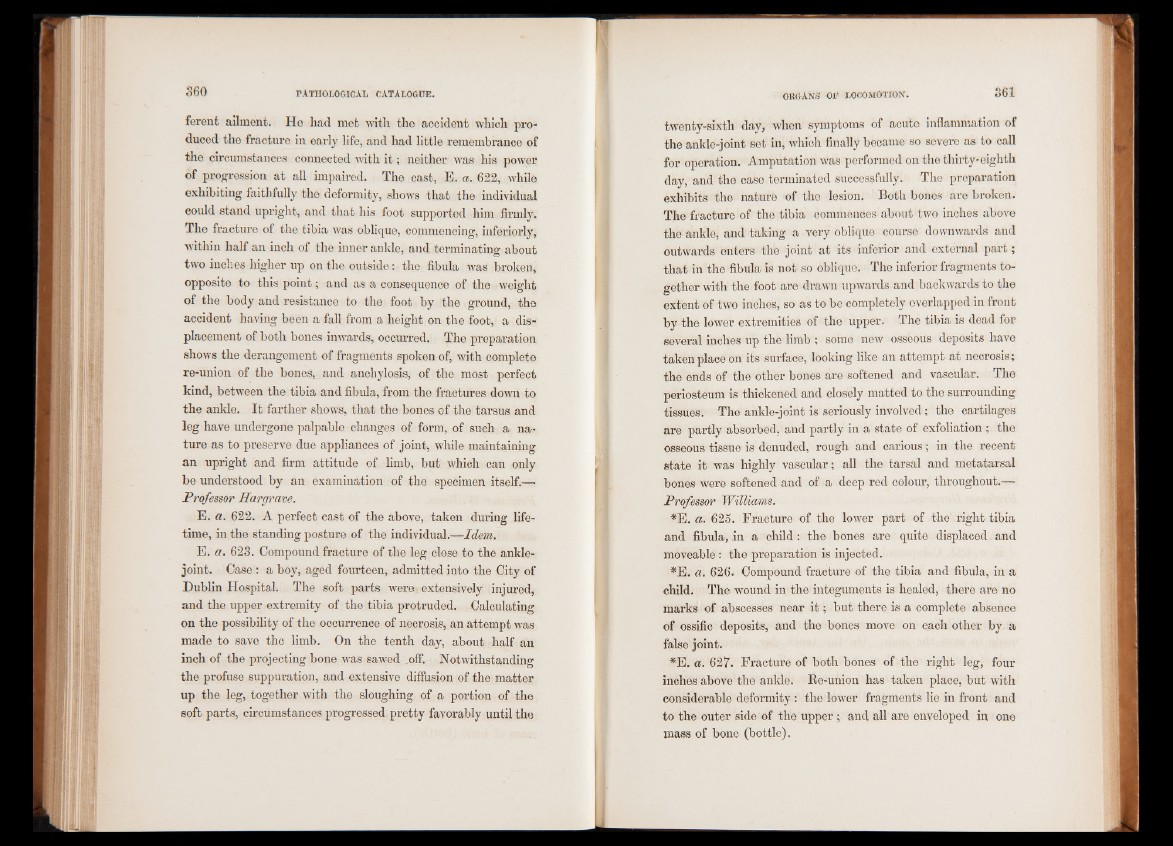
ferent ailment. He had met with the accident which produced
the fracture in early life, and had little remembrance of
the circumstances connected with it; neither was his power
of progression at all impaired. The cast, E. a. 622, while
exhibiting faithfully the deformity, shows that the individual
could stand upright, and that his foot supported him firmly.
The fracture of the tibia was oblique, commencing, interiorly,
within half an inch of the inner ankle, and terminating about
two inches higher up on the outside: the fibula was broken,
opposite to this point; and as a consequence of the weight
of the body and resistance to the foot by the ground, the
accident having been a fall from a height on the foot, a displacement
of both bones inwards, occurred. The preparation
shows the derangement of fragments spoken of, with complete
re-union of the bones, and anchylosis, of the most perfect
kind, between the tibia and fibula, from the fractures down to
the ankle. It farther shows, that the bones of the tarsus and
leg have undergone palpable changes of form, of such a nature
as to preserve due appliances of joint, while maintaining
an upright and firm attitude of limb, but which can only
be understood by an examination of the specimen itself.—
Professor Hargrave.
E. a. 622. A perfect cast of the above, taken during lifetime,
in the standing posture of the individual.—Idem.
E. a. 623. Compound fracture of the leg close to the ankle-
joint. Case : a boy, aged fourteen, admitted into the City of
Dublin Hospital. The soft parts were extensively injured,
and the upper extremity of the tibia protruded. Calculating
on the possibility of the occurrence of necrosis, an attempt was
made to save the limb. On the tenth day, about half an
inch of the projecting bone was sawed _off‘. Notwithstanding
the profuse suppuration, and extensive diffusion of the matter
up the leg, together with the sloughing of a portion of the
soft parts, circumstances progressed pretty favorably until the
twenty-sixth day, when symptoms of acute inflammation of
the ankle-joint set in, which finally became so severe as to call
for operation. Amputation was performed on the thirty-eighth
day, and the case terminated successfully. The preparation
exhibits the nature of the lesion. Both bones are broken.
The fracture of the tibia commences about two inches above
the ankle, and taking a very oblique course downwards and
outwards enters the joint at its inferior and external part;
that in the fibula is not so oblique. The inferior fragments together
with the foot are drawn upwards and backwards to the
extent of two inches, so as to be completely overlapped in front
by the lower extremities of the upper. The tibia is dead for
several inches up the limb ; some new osseous deposits have
taken place on its surface, looking like an attempt at necrosis;
the ends of the other bones are softened and vascular. The
periosteum is thickened and closely matted to the surrounding
tissues. The ankle-joint is seriously involved; the cartilages
are partly absorbed, and partly in a state of exfoliation ; the
osseous tissue is denuded, rough and carious; in the recent
state it was highly vascular; all the tarsal and metatarsal
bones were softened and of a deep red colour, throughout.—
Professor Williams.
*E. a. 625. Fracture of the lower part of the right tibia
and fibula, in a child: the bones are quite displaced and
moveable: the preparation is injected.
*E. a. 626. Compound fracture of the tibia and fibula, in a
child. The wound in the integuments is healed, there are no
marks of abscesses near i t ; but there is a complete absence
of ossific deposits, and the bones move on each other by a
false joint.
*E. a. 627. Fracture of both bones of the right leg, four
inches above the ankle. Re-union has taken place, but with
considerable deformity : the lower fragments lie in front and
to the outer side of the upper; and all are enveloped in one
mass of bone (bottle).